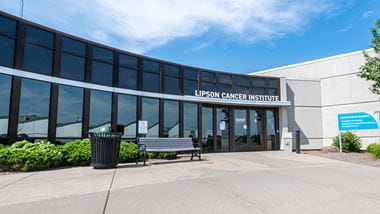Treatment for cancer may vary depending on your medical condition, type of cancer, stage of cancer, and your lifestyle. At Lipson Cancer Institute, our experts create personalized treatment plans designed to meet your individual needs.
If you have been diagnosed with cancer, you will play an important role in the treatment process. Offering input, asking questions, and expressing your concerns about treatment can help create a better experience.
Medical therapies for cancer are drug treatments, often called "systemic" treatments, that spread throughout the body to treat cancer cells wherever they may be. Common medical treatments include:
Chemotherapy uses anti-cancer drugs to kill cancer cells or help stop or slow their growth. Depending on your cancer type and its stage, chemotherapy may be used to cure your cancer, prevent further spread, kill cancer cells, decrease the size of a tumor, or relieve symptoms caused by cancer.
Chemotherapy drugs can be taken orally in the form of tablets or pills that you swallow, intravenously (IV) through a vein, injection with a shot into a muscle or below the skin, or topically as a cream applied to the skin.
If chemotherapy is a part of your treatment plan, your care team will explain why it’s a good choice for you.
Some types of cancer, such as breast cancer and prostate cancer, are fueled by your body's hormones.
Hormone therapy, also called hormonal therapy, hormone treatment, or endocrine therapy, removes the hormones from your body or blocks their effects to stop the cancer cells from growing. The type of hormones you’ll receive depends on several factors, namely the size and type of your tumor, your age, your health, and the presence of hormone receptors on your tumor.
Immunotherapy, also called biological therapy, is a form of cancer treatment that uses your immune system to attack the cancer cells, similar to the way that it attacks bacteria or viruses.
Immunotherapy can be given in the form of drugs or as a cell-based therapy, which means that we extract and modify a patient’s own immune cells before infusing them back into the body.
Your Lipson Cancer provider will help determine if immunotherapy is right for you.
Radiation therapy, also called radiotherapy, uses high-energy beams, such as X-rays, to destroy cancer cells or stop them from growing. Treatments are carefully planned to deliver as much radiation as possible to the cancer cells while limiting damage to healthy cells.
Radiation therapy can be delivered through external beam radiation, meaning the radiation comes from outside of the body, or through internal radiation therapy (brachytherapy), which uses radioactive sources that are placed into the body. It can be used by itself as the only treatment or in combination with surgery, chemotherapy, or both.
The type of radiation therapy you receive depends on many factors, including the type of cancer, the size and location of the cancer, as well as your age and general health.
Surgery
Surgery is the most direct approach for treating cancer and in some cases, may be the only treatment needed. It may also be combined with chemotherapy or radiation therapy as part of your overall treatment plan. In any case, the goal of surgery is to remove the cancer or as much of the cancer as possible.
Factors that we take into consideration are the type of cancer, where it is located, how quickly the cancer is growing/spreading, as well as your general health.
If you’re a candidate for surgery, our experts at the Lipson Cancer Institute will recommend the approach that gives you not only the best chance for survival but also the best quality of life possible.
Learn More About Surgical Oncology

At Lipson Cancer Institute, we understand that caring for cancer goes beyond just the treatment – there are physical, emotional, and financial aspects that come with it. That’s why we see deeper than a patient’s diagnosis and offer a range of specialized programs that help treat the mind, body, and soul before, during, and after cancer.
Learn more about our integrated care and support services